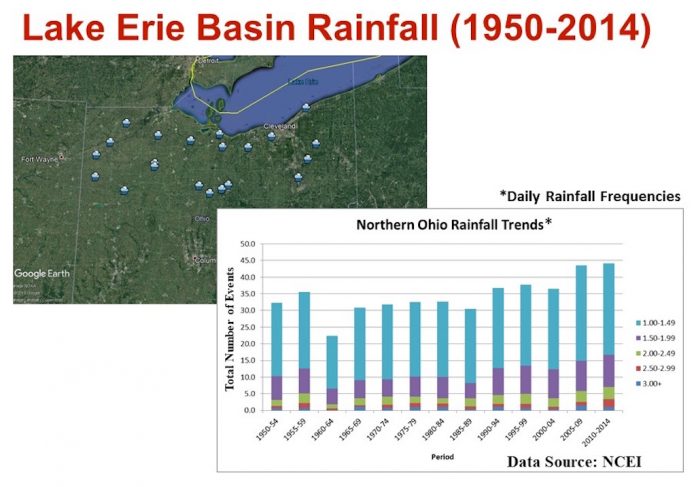
SALEM, Ohio — The first question at the end of the June 20 webinar, “Responses to Our Changing Climate,” was one farmers have been asking for months: “What is causing all of this rain, and when will it end?”
Perhaps, a better question, according to Aaron Wilson, atmospheric scientist at Ohio State University, is: are events of this severity becoming more likely because of climate change?
“The changing climate has a personal face, depending on where you live,” Wilson said.
In Ohio, a changing climate means more “extreme precipitation events.” This includes rainfall up 3-4 inches per year from the early 20th century and affects water quality and quantity, planting and harvesting.
Wilson noted Ohioans have lost about 10 suitable field work days since 1995.
Are climate and weather the same thing?
Wilson said weather is the high frequency changes in temperature, wind speed and moisture we see on a daily basis. Climate is a slower-varying pattern over a longer period of time.
Wilson compared climate and weather to a dog walker and a dog.
“At any one time, that dog could be moving in a different direction than the dog walker, but generally they’re going to end up in the same place … we base that on the path that we see that the dog walker is taking,” Wilson said.
This approach allows scientists to analyze patterns rather than events.
Is the climate changing? Why?
Wilson said scientists have reliable instrumented records dating back to the late 1800s.
These instruments have seen surface and atmosphere warming when looking at the five-year averages since the late 1800s. This warming has sped up since the 1970s.
Wilson said the earth’s atmosphere is the biggest factor in the temperature increase.
The earth absorbs short-wave radiation from the sun and transforms it into long-wave radiation, or heat or infrared light.
Greenhouse gases, mainly carbon dioxide and water, do not absorb short-wave radiation, but do absorb infrared light. The added energy warms the molecules. The more greenhouse gas molecules are in the atmosphere, the warmer it gets.
In the last 50 years, the amount of water vapor and carbon dioxide in the atmosphere have increased.
Is it just a natural cycle?
Wilson said there are natural cycles of climate change. However, he said humans also play a role through greenhouse gas emissions from transportation, electricity production, burning fossil fuels for energy and heat, agriculture and land use and forestry.
Carbon dioxide in the air is measured in parts per million (ppm). Wilson said based on proxy records (think tree rings, ice cores and ocean sediments) going back 800,000 years, the natural cycles go from 180-280 ppm.
Wilson said it was measured at 315 ppm in 1958, and has since increased to 415 ppm.
What about the future?
By the mid-21st century, Wilson predicted temperatures 4-5 degrees warmer than average in Ohio and increased precipitation.
In the near future, Wilson said temperatures for this July are expected to be cooler than average. Precipitation is expected to be on the edge of above normal.
“We are so saturated … normal conditions right now are a problem,” Wilson said. Even a standard inch of rain per week could maintain the current flooding.
What can farmers do?
Wilson said agriculture does contribute to greenhouse gas emission, mainly due to tillage and burning fossil fuels.
“We’ve got to get away from blame, but we do have to have a collective accountability,” Wilson said. He said everyone, regardless of profession, should think about ways to reduce greenhouse gas emissions.
Wilson also said Ohio should be viewed as having a persistent flood risk. The 2018 year checks the boxes for long-term trends Ohioans should expect. He noted there is no single way to adapt.
“There’s likely multiple things we need to do,” he said.
To learn more
You can find more information about climate change in the Midwest from the U.S. Department of Agriculture Midwest Climate Hub. The State Climate Office of Ohio also has more information on climate and agriculture resources.












Such BULLCRAP!!! We were taught in school years ago that there was naturally heating and cooling cycles, as well as wet and dry cycles. What has happened? IT HAS BECOME POLITICAL!! People have not experienced TRUE hunger since the 1930s and have taken food for granted. American farmers have produced the most abundant, safest, and cheapest food in the entire history of mankind, and the newest generations have become thankless, self-absorbed fools who want to ‘pin the blame’ on anyone else but themselves. Instead of pushing self-responsibility, they want to blame farmers, miners, and everyone else who harvests natural resources from Earth. The day these fools give-up electricity and pay extreme prices for food will be the day we farmers will return to real horse power agriculture and use tillage instead of chemicals to control weeds-thus becoming ‘more climate-change’ accountable…..